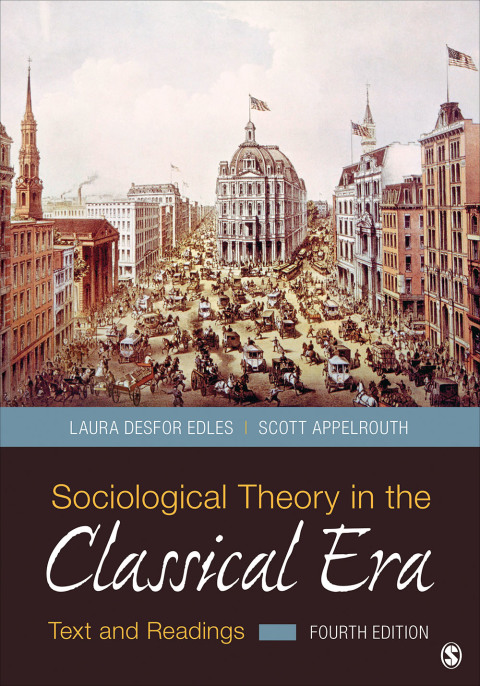Description
Efnisyfirlit
- List of Figures and Tables
- Preface
- About the Authors
- Chapter 1 Introduction
- Key Concepts
- What Is Sociological Theory?
- Why Read Original Works?
- Navigating Sociological Theory: The Questions of “Order” and “Action”
- The Questions of Order and Action and the Opioid Epidemic
- The European Enlightenment
- The Industrial Revolution
- ▶ Significant Others—Auguste Comte (1798–1857): The Father of “Social Physics”
- Political and Religious Transformations
- The French Revolution
- Enlightenment Thinkers and the Questions of Order and Action
- The Limits of Enlightenment
- The Ins and Outs of Classical Canons
- Outline of the Book
- Discussion Questions
- Chapter 2 Karl Marx (1818–1883)
- Key Concepts
- A Biographical Sketch
- Intellectual Influences and Core Ideas
- ▶ Significant Others—Thorstein Veblen (1857–1929): The Leisure Class and Conspicuous Consumption
- Marx’s Theoretical Orientation
- ▶ Significant Others—Antonio Gramsci (1891–1937): Hegemony and the Ruling Ideas
- ▶ Readings
- Introduction to The German Ideology
- From The German Ideology (1845–1846)
- Introduction to Economic and Philosophic Manuscripts of 1844
- From Economic and Philosophic Manuscripts of 1844
- Introduction to The Communist Manifesto
- From The Communist Manifesto (1848)
- Introduction to Capital
- From Capital (1867)
- Discussion Questions
- Chapter 3 Émile Durkheim (1858–1917)
- Key Concepts
- A Biographical Sketch
- Intellectual Influences and Core Ideas
- ▶ Significant Others—Herbert Spencer (1820–1903): Survival of the Fittest
- Durkheim’s Theoretical Orientation
- ▶ Readings
- Introduction to The Division of Labor in Society
- From The Division of Labor in Society (1893)
- Introduction to The Rules of Sociological Method
- From The Rules of Sociological Method (1895)
- Introduction to Suicide: A Study in Sociology
- From Suicide: A Study in Sociology (1897)
- Introduction to The Elementary Forms of Religious Life
- From The Elementary Forms of Religious Life (1912)
- Discussion Questions
- Chapter 4 Max Weber (1864–1920)
- Key Concepts
- A Biographical Sketch
- Intellectual Influences and Core Ideas
- Sociology
- Of Nietzsche and Marx
- ▶ Significant Others—Friedrich Nietzsche (1844–1900): Is God Dead?
- ▶ Significant Others—Robert Michels (1876–1936): The Iron Law of Oligarchy
- Weber’s Theoretical Orientation
- ▶ Readings
- Introduction to The Protestant Ethic and the Spirit of Capitalism
- From The Protestant Ethic and the Spirit of Capitalism (1904)
- Introduction to “The Distribution of Power within the Political Community: Class, Status, Party”
- From “The Distribution of Power within the Political Community: Class, Status, Party” (1925)
- Introduction to “The Types of Legitimate Domination”
- From “The Types of Legitimate Domination” (1925)
- Introduction to “Bureaucracy”
- From “Bureaucracy” (1925)
- Discussion Questions
- Chapter 5 Charlotte Perkins Gilman (1860–1935)
- Key Concepts
- A Biographical Sketch
- ▶ Significant Others—Harriet Martineau (1802–1876): The First Woman Sociologist
- Intellectual Influences and Core Ideas
- Gilman’s Theoretical Orientation
- ▶ Readings
- Introduction to “The Yellow Wallpaper”
- “The Yellow Wallpaper” (1892)
- “Why I Wrote ‘The Yellow Wallpaper’” (1913)
- Introduction to Women and Economics
- From Women and Economics (1898)
- Discussion Questions
- Chapter 6 Georg Simmel (1858–1918)
- Key Concepts
- A Biographical Sketch
- Intellectual Influences and Core Ideas
- Society
- Sociology
- The Individual in Modern Society
- The Individual and Money
- ▶ Significant Others—Ferdinand Tönnies (1855–1936): Gemeinschaft and Gesellschaft
- Simmel’s Theoretical Orientation
- ▶ Readings
- Introduction to “Exchange”
- From “Exchange” (1907)
- Introduction to “Conflict”
- From “Conflict” (1908)
- Introduction to “The Stranger”
- “The Stranger” (1908)
- Introduction to “Fashion”
- From “Fashion” (1904)
- Introduction to “The Metropolis and Mental Life”
- “The Metropolis and Mental Life” (1903)
- Discussion Questions
- Chapter 7 W. E. B. Du Bois (1868–1963)
- Key Concepts
- ▶ Significant Others—Anna Julia Cooper (1858–1964): A Voice from the South
- A Biographical Sketch
- Intellectual Influences and Core Ideas
- Du Bois’s Theoretical Orientation
- ▶ Readings
- Introduction to The Philadelphia Negro
- From The Philadelphia Negro (1899)
- Introduction to The Souls of Black Folk
- From The Souls of Black Folk (1903)
- Introduction to “The Souls of White Folk”
- From “The Souls of White Folk” (1920)
- Discussion Questions
- Chapter 8 George Herbert Mead (1863–1931)
- Key Concepts
- A Biographical Sketch
- Intellectual Influences and Core Ideas
- Pragmatism
- Behaviorism
- ▶ Significant Others—Charles Horton Cooley (1864–1929): The “Looking-Glass Self”
- Evolutionism
- ▶ Significant Others—William James (1842–1910): Consciousness and the Self
- Mead’s Theoretical Orientation
- ▶ Readings
- Introduction to “Mind”
- From “Mind” (1934)
- Introduction to “Self”
- From “Self” (1934)
- Introduction to “Society”
- From “Society” (1934)
- Discussion Questions
- Glossary and Terminology
- References
- Index







Reviews
There are no reviews yet.